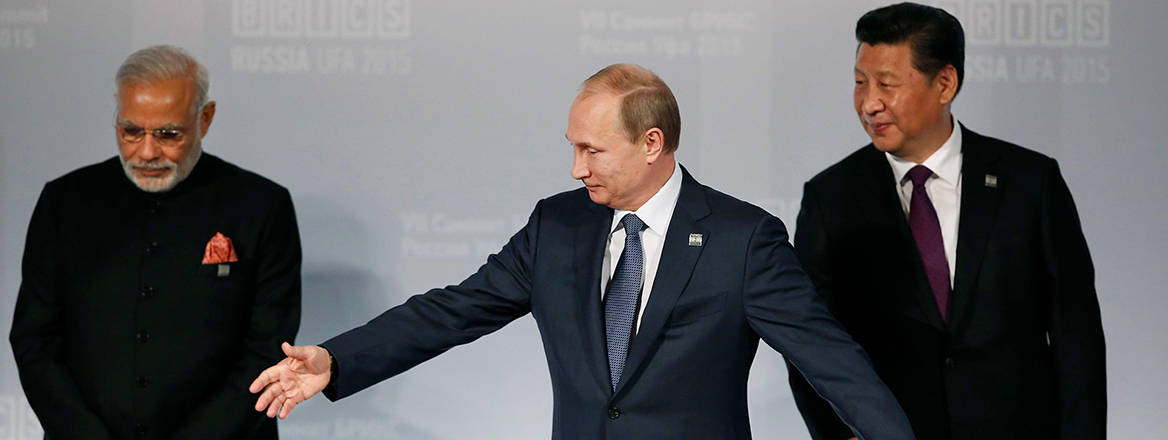India’s Diplomacy of Dual Alignments: Russia and the US
India’s foreign policy divide: realists value Russia and worry about encirclement by a Sino-Russian axis; pragmatists favour the West for technology and economic growth.
India is navigating a volatile global order by asserting its strategic autonomy amid rising tensions between major powers. Historically non-aligned, India follows a flexible foreign policy approach balancing ties with both the West and Russia. Despite US pressure and the mounting threat of sanctions, India maintains deep defence ties with Russia. This cooperation reflects both strategic necessity and energy dependence, with discounted Russian oil now a major import.
In the dim-lit antechambers of global power, India stands as both witness and architect to a world on the edge of multipolar chaos. The tectonic plates of international order are shifting, and New Delhi – long a master of strategic ambiguity – now finds itself the subject of a more perilous experiment in global pressure with Washington brandishing the threat of sweeping tariffs and secondary sanctions. Republican Senator Lindsey Graham’s bill – stipulating 500% tariffs on countries buying Russian oil to curb Moscow’s aggression against Ukraine – puts India’s time-honoured doctrine of ‘strategic autonomy’ to its severest test. NATO Secretary General Mark Rutte’s subsequent warning to India of being hit ‘very hard’ by secondary sanctions if it continues to trade with Russia only underlines the gravity of the challenge.
India’s foreign policy, once defined by the stoic non-alignment of Nehruvian vintage, has undergone a metamorphosis in recent years. No longer content with the passivity of balancing, India now orchestrates a grand pivot strategy, leveraging its unique geography as the hinge between Europe and Asia. This is not mere opportunism, but a conscious recalibration – an attempt to elicit concessions and assurances from both Washington and Moscow, to shape the architecture of regional security to its own advantage.
India’s strategic calculus is undergirded by its defence procurement patterns. Despite overtures from the West, over 60% of India’s military hardware remains Russian in origin – an insurance policy rather than a Cold War relic. The Russian-made S-400 air defence, the BrahMos cruise missile joint venture, and the ongoing localization of the AK-203 rifle serve as potent reminders to adversaries and allies alike that India’s deterrence posture is robust and diversified.
During the recent India-Pakistan 4-day war, the S-400 missile system performed well. By late 2025, India will take delivery of the fourth of five S-400 system, with the final unit due in 2026. The deal, inked in 2018 despite American debates over CAATSA sanctions, signalled India’s enduring commitment to strategic autonomy. In continuing these acquisitions amid the Ukraine war and Western sanctions on Moscow, New Delhi has underscored its refusal to subordinate national security imperatives to external pressure, preserving room to manoeuvre in a shifting geopolitical landscape.
The danger for India is not simply American retaliation for its Russia ties. It is the risk of being caught in a bilateral squeeze, where any move toward one pole is interpreted as betrayal by the other
However, within the Indian foreign policy establishment, a philosophical schism endures. On one side stand the realists, who recall the Soviet vetoes at the UNSC and see the Russia relationship as a sacred trust. For them, to abandon Moscow is to risk strategic orphan-hood and invite encirclement by a Sino-Russian axis stretching from the Himalayas to the Indian Ocean. The pragmatists, however, see a Russia diminished; it has not only become economically dependent on Beijing, but its global influence has also been eroded by the pointless quagmire in Ukraine. They argue for a pivot to American technology and the security umbrella of the Quad, cautioning that continued proximity to Moscow could trigger secondary sanctions and imperil India’s economic ambitions. India’s economy is closely interwoven with the West through robust trade and corporate ties.
Necessity, as ever, asserts itself. India’s energy security is now inextricably tied to Russian crude, which accounts for over a third of its imports. Paradoxically, Western sanctions have only deepened this dependency, offering India discounted oil and a hedge against global price volatility. India exploits the fissures in the Western sanctions regime to secure its own economic stability, even as it diversifies its defence procurement and technology partnerships in the West.
India’s foreign policy now operates within a complex web of overlapping interests and transactional alliances – a ‘Multipolar Manoeuvre Matrix’. The old binaries of democracy versus autocracy, East versus West, have given way to a landscape defined by nuance and flexibility.
In a calibrated assertion of its strategic autonomy, India has deepened its role within the Quad, hosting joint naval exercises alongside the United States, Japan, and Australia in the Bay of Bengal – a maritime signal of Indo-Pacific resolve. This commitment was further highlighted when the foreign ministers of the Quad met in Washington on July 1, for their latest meeting, reinforcing their shared vision for a free and open Indo-Pacific and launching new initiatives on maritime security and critical minerals cooperation. Simultaneously, through the I2U2 initiative and the India-Middle East-Europe Corridor, New Delhi extends its economic and geopolitical reach westward, weaving new ties across the Arabian Peninsula and into Europe. Yet, in a deft balancing act, India sustains robust participation in BRICS, preserving dialogue within alternative, non-Western multilateral frameworks – as reflected in Prime Minister Narendra Modi’s participation in the BRICS Summit held in Rio de Janeiro, Brazil on 6–7 July 2025.
The danger for India is not simply American retaliation for its Russia ties. It is the risk of being caught in a bilateral squeeze, where any move toward one pole is interpreted as betrayal by the other. In India’s strategic calculus, China is the main adversary, with Pakistan serving as a proxy – a ‘borrowed knife’ wielded by Beijing to advance its own agenda. Should India distance itself from Moscow, it risks a reverse pivot – Russia intensifying defence cooperation with Pakistan or becoming wholly dependent on China, both scenarios inimical to Indian security. Conversely, standing too firmly by Moscow could fracture India’s deepening partnerships with the United States and Europe, undermining its aspirations for technological and economic modernization.
Recent incidents illustrate this peril. Reports have surfaced of Russia exploring lucrative deals with Pakistan, underscored by a quiet trade forum held in Moscow in late 2024 – moves widely interpreted as Moscow hedging its bets in South Asia. Though Russia condemned the Pahalgam terror attack, Moscow notably avoided directly blaming Pakistan, reflecting an evasive stance that subtly shields Islamabad. At the same time, American officials have warned of possible sanctions should India continue to expand its defence ties with Russia, even as they court India as a bulwark against China.
To navigate this thicket, India has developed a sophisticated sanctions-evasion strategy. Indian companies, facing the threat of being locked out of the dollar-based global financial system, have sought alternative payment mechanisms – trading in rupees or roubles, and deepening investments in Russian energy assets to generate dividend flows for defence purchases.
This is not mere circumvention; it is a calculated strategy to preserve autonomy in the face of extraterritorial pressure. At the same time, India invests in American industries, creating jobs and goodwill that can be leveraged to temper US policy decisions. The result is a dynamic, adaptive approach that seeks to maximize manoeuvrability while minimizing exposure.
While Western capitals urge decisive alignment and rapid decoupling from Russia, New Delhi moves with deliberate caution. India has abstained on United Nations votes, refused to condemn Moscow outright, and maintained high-level diplomatic engagement with both sides. This patience is a recognition that the tectonic plates of global order are still shifting, and that premature commitments could foreclose future options. Despite mounting pressures, Indo-Russian ties endure. Defence cooperation is institutionalized through regular exchanges, joint military exercises, and co-production deals. The relationship has evolved from a simple buyer-seller dynamic to one of joint research, design, and production – exemplified by projects like BrahMos and the Su-30MKI.
Yet, this circuit is not immune to strain. The growing Sino-Russian partnership, the uncertainties of the Ukraine conflict, and the lure of Western technology all test its durability. Like a chessboard in flux, India must manoeuvre deftly – balancing between opportunity and peril – to ensure this partnership remains an asset, not a strategic liability, amid shifting tectonics of global order.
Indian foreign policy, far from dogma, is a living dialectic. It is an evolving engagement with the world, informed by history yet unshackled by it. In an era defined by unravelling alliances and multiplying crises, India seeks autonomy. The shifting tectonics of global power cannot allow it to remain passive. The burden and privilege before India is to remain the axis upon which the fragile equilibrium of the international order may yet depend.
© Vinay Kaura, 2025, published by RUSI with permission of the authors.
The views expressed in this Commentary are the author's, and do not represent those of RUSI or any other institution.
For terms of use, see Website Terms and Conditions of Use.
Have an idea for a Commentary you'd like to write for us? Send a short pitch to commentaries@rusi.org and we'll get back to you if it fits into our research interests. View full guidelines for contributors.
WRITTEN BY
Vinay Kaura
Guest Contributor
- Jim McLeanMedia Relations Manager+44 (0)7917 373 069JimMc@rusi.org



